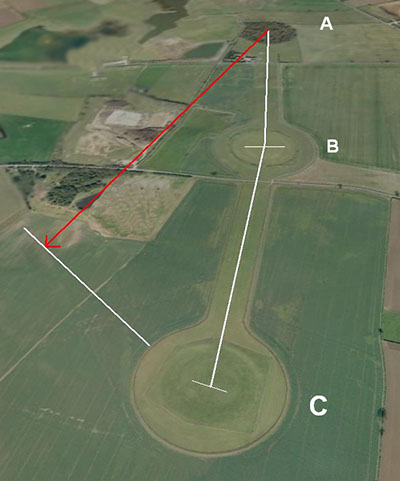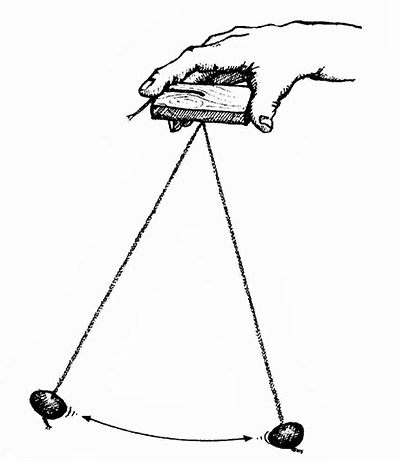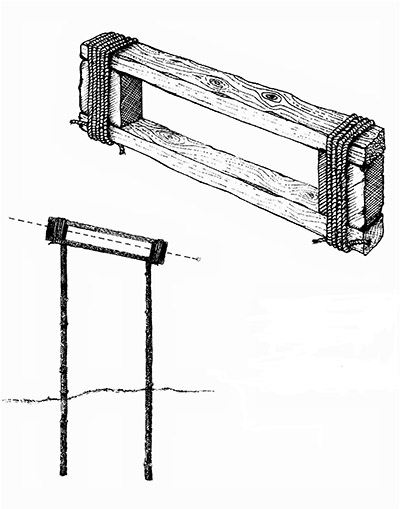More than a decade has passed since we joined forces to try and find out if there was any reality to a claim that highly accurate units of length had been in used during the British Neolithic. We found that these supposedly primitive people were using a highly developed science that connected them to the rhythms of the Earth.
But our biggest personal challenge has been to face up to the consequences of our own findings because they have brought us to the point where we have found compelling evidence that our planet and its environment has been carefully designed for us. Stranger still, there appears to be a message built into the very fabric of the solar system itself.
This was not a finding that we had looked for or even care for. We are very pragmatic people working in an area of ancient research that is specialised and very sober.
In early 2009 we decided to revisit all of our findings that had resulted in three joint books plus one still in draft manuscript form (now published). We were troubled because despite one of us being an agnostic and an atheist, we could not escape the conclusion we were looking at a message from what we called the UCA (Unknown Creative Agency) that had designed our solar system and all life on Earth.
Then in late November 2009 we were contacted by David Cumming, an expert in AI (artificial intelligence) who had studied our evidence in great detail and independently come to the same conclusion. He claimed that it formed an equation with a very clear message from the creator. The equation and the mathematics of our discoveries is discussed later in this article.
The Origin of the Megalithic Yard (MY)
The starting point of our joint research was simply to consider whether Alexander Thom had been right or wrong in his identification of a prehistoric unit he called the Megalithic Yard (MY). He was a professor of engineering at Oxford University who surveyed hundreds of Megalithic sites over the course of half a century to 1985. Thom concluded the planners and builders must have been highly skilled engineers. He deduced the builders had all been working to a common set of units based on the Megalithic Yard that was 2.722 +/- 0.002 feet (829.7 +/- 0.5 mm). Thom was viewed as an unwelcome outsider by nearly all archaeologists.
Our starting hypothesis was that if the Megalithic Yard were real, then it is highly probable that its apparent accuracy can best be explained as being derived from nature. If we could identify a natural origin, then Thom was probably right.
It did not take too long for us to realise there is only one aspect of nature that delivers up a near perfect means of creating measures – the revolving of the Earth on its axis. This provides the potential for creating a unit of time that can then be used to make units of length, weight and capacity – and potentially everything else from frequency to temperature.
The most obvious way to observe the turning of the Earth is to watch the stars, which appear to pass overhead once for each rotation. They also move across the sky in an annual rotation due to the Earth’s orbit of the Sun. Megalithic astronomers could not help but notice there where 366 of the daily star movements to one annual one.
We know that ancient peoples from across time liked to create patterns where the same values work upwards and downwards. And we had good reason to believe that early stargazers had used a 366 day calendar and a 366 degree circle. These astronomers knew there are 366 star rises (any star such as Sirius) over one circle of the Sun, so it was logical to divide the horizon into 366 parts to measure time in 1/366th part of a day.
They measured time in the same way that all clocks did until recent times – with a pendulum. A hand-held ball of clay on a string is a perfect instrument. When stationary it is a plumb line to gauge verticals and when swinging its beats measure time with great accuracy. The only factors that have any significant effect on the beat are the length of the pendulum from fulcrum to the centreline of the weight and the mass of the Earth (gravity). The energy put into the swing by the user has no effect – if the swing is made more vigorous it just swings faster in a wider arc but the rate of beat remains exactly the same.
Our first and most obvious assumption was that Megalithic people had divided the horizon up into 366 equal parts and then used a pendulum length that beat 366 times.
We found that a pendulum that beat 366 times during one 366th of the Earth’s turn was, much to our joy and amazement, half a Megalithic Yard in length! A circle scribed by such a pendulum would have a diameter of one Megalithic Yard. Archie Roy, emeritus professor of astronomy at Glasgow University (and a friend of the late Alexander Thom) joined us to give a public demonstration of how the Megalithic Yard is a product of measured observational astronomy.
We later refined the timing method, having realised that the Megalithic astronomers had improved their own accuracy by using the movement of the planet Venus at certain times rather than a star. Gordon Freeman, a distinguished professor of chemical physics and a much-published amateur archaeologist specialising in the Megalithic structures, was impressed with this saying; “Tying the MY to Venus path arcsecond is a major discovery. I’m an admirer of Thom, but was neutral about the MY. Now I’m a convert.”
Alexander Thom had been right all along because the chances of this technique producing a perfect fit for his unit could not be a coincidence. But there was more – much more to this system. Given that the builders of these Megalithic sites some 5,000 years ago used a 366 degree circle caused us to look at the Earth itself. Taking the polar circumference as the textbook 40,000,000 metres, we turned it into Megalithic units and found this:
Earth’s polar circumference = 40,000,000 metres
1 Megalithic degree (1/366th) = 109290 metres
1 Megalithic minute of arc (1/60th) = 1822 metres
1 Megalithic second of arc (1/6th) = 303.6 metres
Now, 303.6 metres for a second of arc may look a little boring but it is exactly 366 Megalithic Yards!
The Megalithic second of arc appears to have been adopted later by the Minoan culture of Create some 4,000 years ago. The palaces of Crete were carefully surveyed by Canadian archaeologist J.W. Graham who identified a standard unit he called “the Minoan foot” of 30.36cm. It follows that 1,000 of these feet make precisely one Megalithic second of arc.
Even earlier, the ancient Egyptian culture had adopted units driven by the same thinking. They took the Megalithic Yard and made it the circumference of a circle. The diameter of that circle was called a royal cubit and the hypotenuse of a square from that diameter was called a remen.
Artefact Based Evidence
When we wrote Civilization One, we stated that the people who created the Megalithic Yard must have built very large circles and divided the circumference into 366 parts to be sure they were viewing 1/366th part of the night sky. We suggested they may well have understood a quick method to do this by making a circle with a diameter 233 units (any length would do if they didn’t already have a Megalithic Yard). They then knew they would have a circle of 732 units – which is twice 366, so they could take every other pole on the circumference. This is a 99.999% accurate means of using Pi in a practical manner. For all engineering purposes, this means is perfect.

The Thornborough henges, a perfect copy of the stars of Orion’s Belt. A to B is 366 Megalithic rods, B to C is 360 Megalithic rods and the true north/south latitudinal distance (black line) is 3 Megalithic seconds of arc.
Several years later we found that structures even older than Megalithic monuments demonstrated the use of the 233/732 circles – exactly as we had predicted. These are henges – large circular mounds such as the group near Thornborough in North Yorkshire, England. They were built around 3500 BCE, well before the Megalithic builders began their stonework phase. What is more, they were using the Megalithic Yard. At Thornborough there are three interlinked henges that are 233 MY across and 732 MY around their outer perimeter. These structures are measurable with units and ratios being 366 Megalithic Rods between the centres of the first two and 360 between the second. The trio, which are also exactly 3 Megalithic seconds of arc apart by latitude, have also been identified as being laid out as a copy of the stars of Orion’s Belt – exactly like the Giza pyramids. The difference is that these are a thousand years older. We explain in our book Before the Pyramids how Khufu’s pyramid builders came to this location in England to get instructions on how to plan this star pattern on the ground!
Weights and Measures
Having established that the people of the British Neolithic had units of lengths and time, we wondered if they had other units such as capacity and weight. We knew (or so we thought) that the Metric system was devised by the French in the late 18th century when they used a pendulum that beat at the rate of one second to create a unit they called the metre (meaning to beat out time). They later made a very small adjustment so their metre was one 10,000,000th of the distance from the equator to the north pole. To create a unit of capacity they took a 1/10th part of the metre (10cm) and made a cube. Filled with distilled water, this cube’s capacity was called a litre and its weight was designated a kilogram.
We applied the same logic to the Megalithic Yard, (which has 40 Megalithic Inches). We calculated what a 4 Megalithic Inch cube would contain. The answer is one pint – to an accuracy of one part in 5,000 as defined by the British government in 1601. And when carefully filled with any unpolished grain, such as barley, it weighed just one Imperial pound.
This was odd in the extreme but it appears that (unknown to history) Imperial units were indeed based on cubes because by doubling the sides of the cube to 8 Megalithic Inches holds one Imperial gallon and doubling again produced a unit equivalent to a bushel, which was used as a dry weight until recent times.
Next, we found some truly bizarre connections. We thought for thoroughness that we ought to consider the volumes of spheres with Megalithic dimensions in addition to the cubes: a 6 Megalithic Inch sphere held a litre and a 1.5 MY wide sphere of water weighs a metric tonne. The level of accuracy was not spot on, but at a level of 99% we were surprised to put it mildly.
We are used to modern measurements that are ad hoc, but the 366 system works in depth. Take just two examples:
1. Earth mass
One Megalithic degree (366th) slice of the Earth = 360 x 1020 pounds
One Megalithic minute slice of the Earth = 6 x 1020 pounds
One Megalithic second slice of the Earth = 1020 pounds
2. Temperature (hypothetical scale)
Water freezes @ 0 degrees
Water boils @ 366 degrees
Absolute zero @ – 1,000 degrees
The Jefferson Paradox
Thomas Jefferson, one of the Founding Fathers of the United States, was an amazing polymath. He set out to create a new system of units which were never adopted. He started by looking at what means nature provided for producing a repeatable unit and, like us, he quickly identified the spinning of the Earth and he used a pendulum that beat at the rate of once per second as his starting point.
Thomas Jefferson had unknowingly connected back into the system from prehistory. The following is true:
1,000 Jefferson Feet = 360 Megalithic Yards
366 Jefferson Furlongs = 1 Megalithic degree of arc of the Earth
3662 Jefferson Furlongs = The exact circumference of the Earth
This is a case-winning piece of evidence!
The Sun and the Moon
It is strange that the disc of the Moon should appear to be exactly the same size as the Sun. The Moon is obviously tiny compared to the Sun, and is much closer to Earth, but they still appear as equal discs. To be precise, the Moon is 400 times smaller than the Sun but is 400 times closer to the Earth. Strange!
The odds against this happening at all are huge – but how bizarre that both values are the same, round number. Isaac Asimov, the respected scientist and science-fiction guru, described this perfect visual alignment as being, “the most unlikely coincidence imaginable.”
This perfect fit only works at this point in time because it was very different in the distant past and it will change again.
The strangeness of the Moon continues because it is either hollow or made up of extremely low density material. It centres of mass are just below its surface. Odd!
Applying the Megalithic 366 system of geometry and MYs to the Moon and the Sun produces an astonishing result:
One Megalithic second on Moon = 100 Megalithic Yards
One Megalithic second on Sun = 40,000 Megalithic Yards
It is almost as though we are looking at the blueprint of the solar system.
The Rhythm of the Solar System
Looking closely at every aspect, the following values also stand out:
366
The number of complete rotations of the Earth in a year
The number of MY in a Megalithic second of arc on the Earth
The percentage size of the Earth compared to the Moon
100
The number of MY in a lunar Megalithic second of arc
The number of times the Earth rotates faster than the Moon
400
The Sun is larger than the Moon
The number of kilometres the Moon turns on its axis in a day
The number of times the Moon is closer to the Earth than the Sun
10,000
The number of times faster that light travels in a vacuum compared to Earth’s speed of orbit around the Sun
The number of Earth turns in an orbit of the Sun x the number of Earth turns in one lunar orbit of the Earth
40,000
The number of kilometres to Earth’s polar circumference
The number of MY in a solar second of arc
1,000,000
The number of times faster that light travels in a vacuum compared to the Moon’s speed of orbit around the Earth
109.25
The number of Earth diameters to the Sun’s
The number of solar diameters across the maximum diameter of the Earth’s orbit around the Sun
27.322
The number times the Earth turns in one turn of the Moon
The percentage size of the Moon to the Earth
The Message
Are we looking at ‘God’s blueprint’? These integer numbers could not possible fall out of the Earth – Moon – Sun relationship by accident when every other solar system body appears to have no rules whatsoever.
The Search for Extraterrestrial Intelligence (SETI), originally set up by NASA, spends a vast amount of energy searching for radio messages from a non-human origin based on the belief that we are probably not alone. Professor Christopher Rose and Dr. Gregory Wright have suggested:
“Rather than transmitting radio messages, extraterrestrial civilisations would find it far more efficient to send us a ‘message in a bottle’, some kind of physical message inscribed on matter. And it could be waiting for us in our own backyard.”
Could the Moon have been constructed as a message by integrating ratios and values of both the Sun and the Moon?
Could humans have been ‘seeded’ on a planet that would sustain us? The Moon is an ‘incubator’ to nurture life. No Moon would mean no humans.
Which brings us to David Cumming’s idea that all of this can be expressed as an ‘equation’ that formally identifies there is a message.
The Equation
The equation describes a relationship between the hydrogen fine transition line, the ratio between the circumference and diameter of a circle, and the speed of light in a vacuum.
The top line of the equation, Hlf.π is the hydrogen line – a universal value used as the search frequency by SETI (the Search for Extra-Terrestrial Intelligence).
Omega is the number 0.0123456789 – all the characters of the base 10 number system. Standard physics says that the frequency of a wave, multiplied by the wavelength of that wave, is equal to the speed of the wave. In the case of the equation, when you divide out π/Ω, the answer must be equal to the wavelength of the hydrogen line, because the hydrogen line frequency multiplied by the hydrogen line wavelength must equal the speed of light.
When we look at the overall equation, we know in advance that the equation will give the value for the speed of light very accurately because what we’re doing is multiplying the frequency of the hydrogen line by the wavelength of the hydrogen line. But remember, we’ve divided π (3.141592653) by Ω (0.0123456790) to get a result for the hydrogen line wavelength expressed in MYs, so the fact that we get a highly accurate answer appears to be nothing short of a miracle.
The speed of light calculated using the equation is 1420,405,751 cycles per sec (frequency [Hz]) multiplied by 0.2544690072 MY (wavelength). This works out at 361,449,241.3 MY per second – the speed of light in Stone Age units!
Amongst the many surprises of the last few years, there is one we came across in early 2009 that stumped us. As we explain in Before the Pyramids, there can be no doubt that the Founding Fathers of the USA secretly designed Washington DC using Megalithic seconds of arc for every detail of the City plan. It is still happening. The Pentagon is a perfect and inspirational exposition of Stone Age knowledge – using the 366 system with as much perfection as Stonehenge or Thornborough.
And this was driven by the 33rd degree of the Ancient Scottish Rite of Freemasonry. Presidents and people unknown have been driven to build a city using God’s own values – a city fit for God’s great purpose.
Do the powers that be in the USA already understand this message? Are they preparing to respond? Is there a new dawn ahead?
Illustrations courtesy of the authors. Much more on the above is available in Christopher Knight and Alan Butler’s book Before the Pyramids: Cracking Archaeology’s Greatest Mystery (Watkins, 2009), available from all good bookstores.
© New Dawn Magazine and the respective author.
For our reproduction notice, click here.





